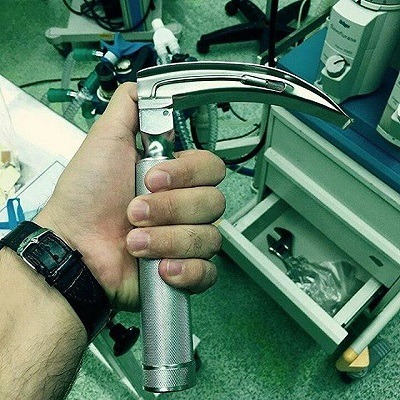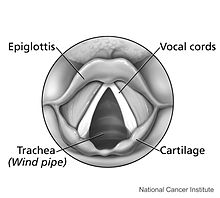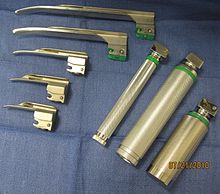لارینگوسکوپ(Laryngoscope)
لارینگوسکوپ(Laryngoscope) از دو کلمه Laryngo به معنی حنجره وscope به معنی نمایش یا نشان دادن است و در کل به معنی وسیله ای جهت دیدن حنجره (خشک نای) است.
لارنگوسکوپ برای معاینه ی حلق و حنجره به کار می رود و به عبور یک لوله داخل تراشه از نای کمک می کند. این وسیله از یک دسته که
دارای باتری است و یک تیغه که دارای لامپ نور است، تشکیل شده است.
هنگامی که تیغه باز شده و برای استفاده در محل قفل می شود، چراغ روشن می گردد. تیغه ها در شکل ها و اندازه های مختلفی برای
تطبیق با نیاز های مختلف موجود هستند،مثلا برای استفاده در بزرگسالان یا کودکان .
آناتومی و فیزیولوژی حنجره
حنجره قسمتی از راه هوایی است که بین دهان و نای قرار دارد و به عنوان ” تارهای صوتی ” نیز شناخته شده است. زمانی که بیمار به تنفس
مصنوعی نیاز دارد، یک لوله به نام ” لوله ی داخل شونده به نای ” از طریق دهان یا بینی، وارد نای می شود.
وقتی لوله کاملادر محل نای قرار گرفت، پزشک با استفاده از لارنگوسکوپ، زبان را به آرامی به سمت بالا هدایت می کند تا بتواند از درستی
مسیر لوله و هدایت صحیح لوله به سمت ریه ها اطمینان حاصل کند.
نحوه ی کارکرد دستگاه
لارنگوسکوپ شامل یک دسته و تیغه است. تعدادی باتری در دسته آن قرار داده شده است که در برخی از انواع آن، قابل شارژ هستند.یک
لامپ نوری کوچک نیز بر روی دسته یا تیغه قرار دارد. لارنگوسکوپ هایی که لامپ بر روی آن ها قرار دارد، یک مسیر فیبر نوری ضعیف از لامپ به انتهای تیغه کشیده شده است.
هنگامی که لارنگوسکوپ در ناحیه مورد نظر قرار گرفت، لامپ روشن می شود. تیغه درون دهان قرار داده می شود و پزشک می تواند حرکت
انتهای تیغه تا رسیدن به حنجره را مشاهده کند. تیغه لارنگوسکوپ اندازه های متفاوتی دارد که برای افراد بالغ، کودکان و نوزادان قابل
تغییراست. در اکثر مواقع اندازه های مختلف تیغه به همراه یک دسته در یک مجموعه عرضه می شود.
موارد کاربرد :
یکی از موارد استفاده از لارنگوسکوپ لوله گذاری است .

لارینگوسکوپ 3
انواع لارنگوسکوپ
لارنگوسکوپ ها از نظر ساختار داخلی نور به دو دسته تقسیم می شوند:
- لارنگوسکوپ استاندارد : در این نوع لارنگوسکوپ چراغ روی تیغه قرار دارد.
- لارنگوسکوپ فایبر اپتیک ( فیبر نوری ) : در لارنگوسکوپ های فایبر اپتیک لامپ درون هندل قرار دارد و نور تولید شده، توسط فیبرهای نوری که روی تیغه قرار دارند به نوک تیغه منتقل می شود.
مزیت های لارینگوسکوپ فایبر اپتیک نسبت به لارنگوسکوپ استاندارد
- فیبر نوری را با شدت و تمرکز بیشتری در اختیار پزشک قرار می دهد.
- به علت نداستن اتصالت الکتریکی (لامپ ) در هد، این قسمت قابل اتوکلاو می باشد.
- به علت نداشتن اتصالات الکتریکی (لامپ) در هد،این قسمت آسیب نمی بیند و خراب نمی شود.
- تیغه ها از نظر شکل به دو دسته تقسیم می شود:
- تیغه های منحنی
- تیغه های صاف

لارینگوسکوپ 1
Laryngoscopy
Laryngoscopy (/ˌlærɪŋˈɡɒskəpi/) is endoscopy of the larynx, a part of the throat. It is a medical procedure that is used to obtain a view, for example, of the vocal folds and the glottis.
Laryngoscopy may be performed to facilitate tracheal intubation during general anaesthesia or cardiopulmonary resuscitation or for surgical procedures on the larynx or other parts of the upper tracheobronchial tree.
Direct laryngoscopy
Direct laryngoscopy is carried out (usually) with the patient lying on his or her back; the laryngoscope is inserted into the mouth
on the right side and flipped to the left to trap and move the tongue out of the line of sight, and, depending on the type of
blade used, inserted either anterior or posterior to the epiglottis and then lifted with an upwards and forward motion (“away from you and towards the roof “).
This move makes a view of the glottis possible. This procedure is done in an operation theatre with full preparation for
resuscitative measures to deal with respiratory distress. There are at least ten different types of laryngoscope used for this
procedure, each of which has a specialized use for the otolaryngologist and medical speech pathologist.
This procedure is most often employed by anaesthetists for endotracheal intubation under general anaesthesia, but also in direct
diagnostic laryngoscopy with biopsy. It is extremely uncomfortable and is not typically performed on conscious patients, or on patients with an intact gag reflex.
Indirect laryngoscopy
Indirect laryngoscopy is performed whenever the provider visualizes the patient’s vocal cords by a means other than obtaining a
direct line of sight (e.g. a mirror). For the purpose of intubation, this is facilitated by fiberoptic bronchoscopes, video
laryngoscopes, fiberoptic stylets and mirror or prism optically-enhanced laryngoscopes.
History
Some historians (for example, Morell Mackenzie) credit Benjamin Guy Babington (1794–1866), who called his device the
“glottiscope”, with the invention of the laryngoscope. Philipp von Bozzini (1773–1809) and Garignard de la Tour were other early
physicians to use mouth mirrors to inspect the oropharynx and hypopharynx.
In 1854, a Spanishvocal pedagogist named Manuel García (1805–1906) became the first man to view the functioning glottis and
larynx in a living human. García developed a tool that used two mirrors for which the Sun served as an external light source.
Using this device, he was able to observe the function of his own glottic apparatus and the uppermost portion of his trachea. He
presented his findings at the Royal Society of London in 1855.
All previous observations of the glottis and larynx had been performed under indirect vision (using mirrors) until 23 April 1895,
when Alfred Kirstein (1863–1922) of Germany first described direct visualization of the vocal cords.
Conventional laryngoscope
The vast majority of tracheal intubations involve the use of a viewing instrument of one type or another.
Since its introduction by Kirstein in 1895, the conventional laryngoscope has been the most popular device used for this purpose.
Today, the conventional laryngoscope consists of a handle containing batteries with a light source, and a set of interchangeable blades.
Laryngoscope blades
Early laryngoscopes used a straight “Magill Blade”, and this design is still the standard pattern veterinary laryngoscopes are based
upon; however the blade is difficult to control in adult humans and can cause pressure on the vagus nerve, which can cause
unexpected cardiac arrhythmias to spontaneously occur in adults.



